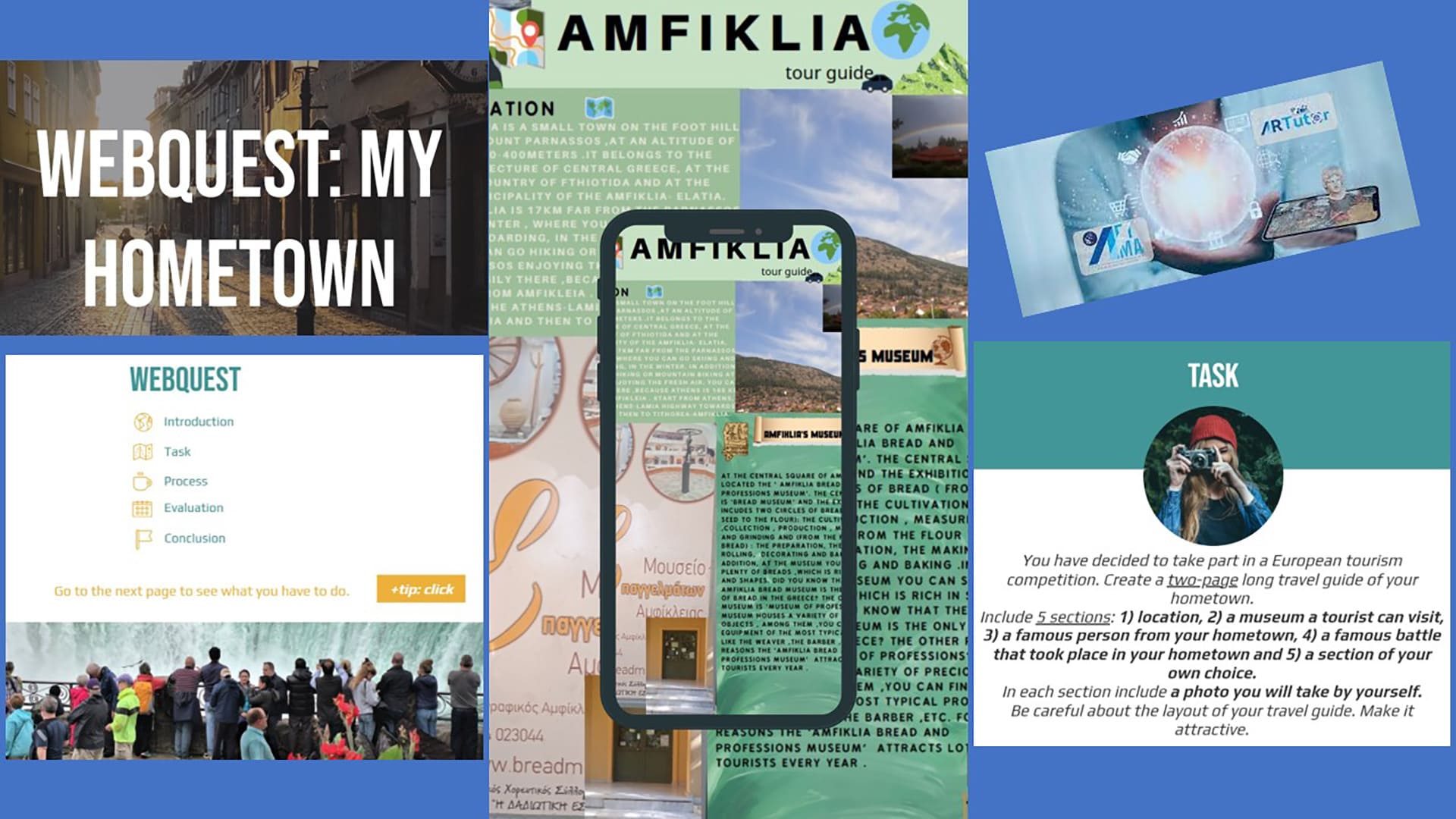In this project, an original webquest1 was created by the teacher and implemented according to the project-based framework. The goal of the project was the creation of a tour guide of Amfiklia, the town in which our school is located. The learners were involved in a creative process in which they were carefully guided so as to make an original contribution of their own.
By Christina Laiou, State School Teacher, Amfiklia
The group of learners involved in this project was the advanced class of second grade junior high school students. There were twenty-five students in the class, mainly Greek and some Albanian, aged thirteen or fourteen. Most students were at the B2 “Vantage” level according to the CEF scale (Council of Europe, 2020). The coursebook taught was Think Teen, 2nd Grade of Junior High School (advanced) (Giannakopoulou et al., 2009a) which aims at Threshold B1 level.
The challenge in this context was, that the class involved, was a mixed-ability class. In order to overcome this difficulty, the teacher engaged students in group work so as to encourage learners to contribute what they could since there was always someone who could make up for any weaknesses. Thus, the fear of failure was alleviated. Furthermore, the teacher had designed the activities in a way that provided scaffolding for the learners to succeed. This was where mediation tied in, as the L1 (first language) was viewed as a resource rather than a problem (Canagarajah, 2006). How mediation was exploited in the project will be explained further on.
The aim and end product of the project was a digital tour guide of Amfiklia. There were several objectives related to this aim. The learners would:
- practice scanning online texts for specific information.
- practice mediation (Council of Europe, 2020).
- be able to write descriptions of places, people and events.
- practice new literacy skills and the use of digital tools.
- practice collaboration and creativity skills.
The process was implemented in about one month. Students worked both at school, in the computer laboratory, and at home. They used online tools to create their work (google docs or canva) and they made use of the eclass asynchronous platform in which a link to the webquest was provided. The project was fully online.
The teacher began by creating interest through questions (e.g., “What would you show a visitor to Amfiklia?”). Next, the webquest was placed in a realistic scenario since the learners were taking part in a European tourism competition. Accordingly, guidelines were given as to how to make the tour guide. The guide was to be two pages long with five sections: 1) location, 2) a museum a tourist can visit, 3) a famous person from their hometown, 4) a famous battle that took place in their hometown and 5) a section of their own choice. For each section, hyperlinks were provided as sources of information, except of course for the last part. Some texts were Greek; thus, learners were required to act as mediators by relaying information they read in their L1 to write their own texts in the English language.
Learners were then asked to add a photograph to each section, which they would take on their own. The aim was to raise awareness of copyright issues and to foster creativity. Further on, the teacher presented the rubric according to which students would be evaluated. Finally, the learners formed groups to tackle the project. Fortunately, learners were accustomed to this mode of work.
Finally, the project was tweaked further by adding a second stage. Students were asked to add augmentations to their photographs using the free Augmented Reality Educational Platform ARTutor2. This stage also lasted about one month since the teacher had to present the platform and explain its use. Students then created accounts on the platform, uploaded their PDF tour guides and added augmentations to the photographs in their tour guide. The augmentations can be ‘read’ by using the free ARTutor application for mobile devices.
The overall impact of the project is that learners had fun! All objectives were attained. Students enjoyed creating a tour guide of their town and they were surprised that they actually learned about Amfiklia from the project. The mediation activities initially seemed daunting, but they were completed successfully. The issue of copyright was extensively discussed and learners were enlightened. Finally, the incorporation of ARTutor helped learners acquire yet a new skill; the ability to create their own augmented reality material.
I plan to continue designing interesting projects with my students so as to motivate them to keep learning English in a way that is creative, relevant, fun and modern. I rarely do the same thing twice. This means that I am always on the lookout for inspiration from any source possible; I can only hope that my project will inspire other teachers!
Useful Links
1: https://view.genial.ly/632779b6b1ca2700117bcc63/presentation-webquest-my-hometown
2: http://artutor.ihu.gr/home/
References
Canagarajah, S.A. (2006). Toward a writing pedagogy of shuttling between languages: Learning from multilingual writers. College English, 68 (6), 589 – 604.
Council of Europe (2020). Common European framework of reference for languages: learning, testing, assessment: Companion volume. Strasbourg: Council of Europe Publishing.
Giannakopoulou, A., Giannakopoulou, G., Karampasi, E. & Sofrona, T. (2009a). Think Teen 2nd Grade Junior High School, Student’s book (Advanced). Athens: Pedagogical Institute, Organismos Ekdoseon Didaktikon Vivlion.
